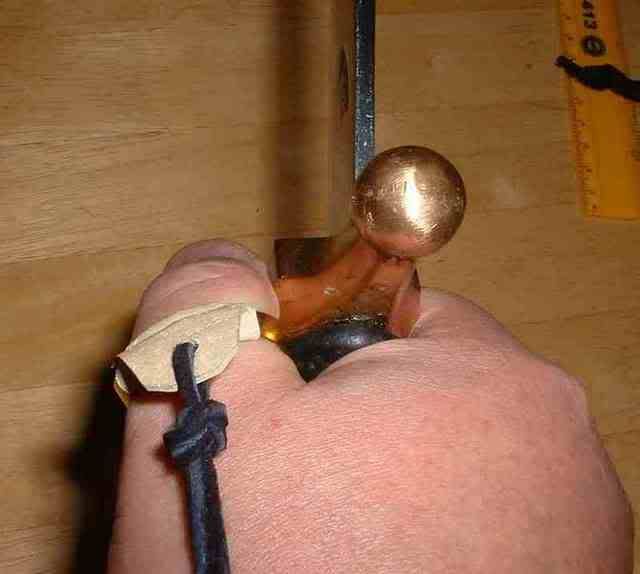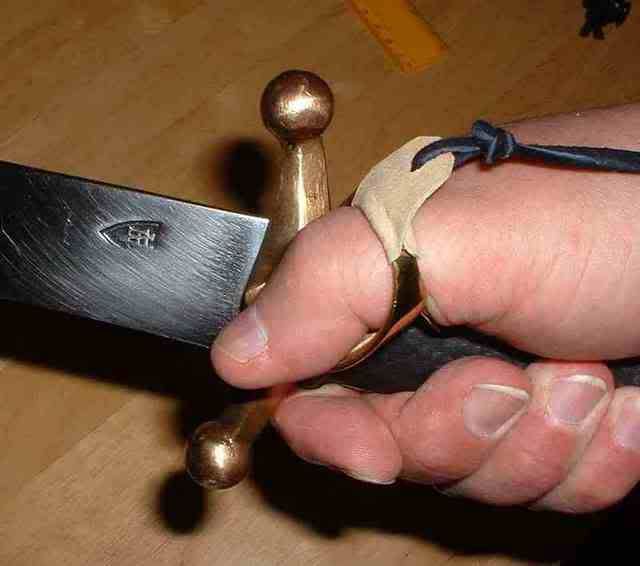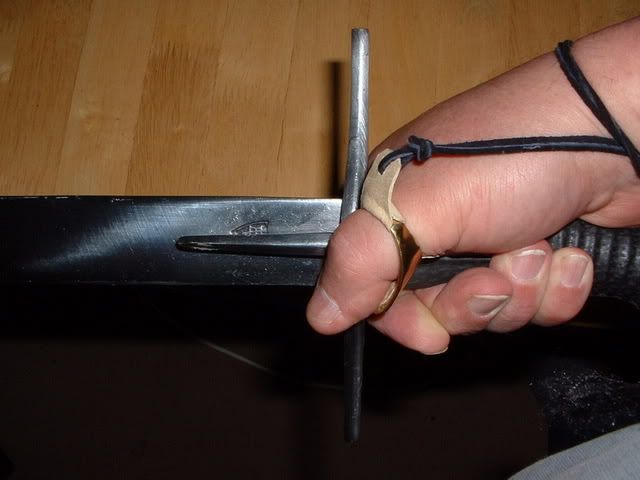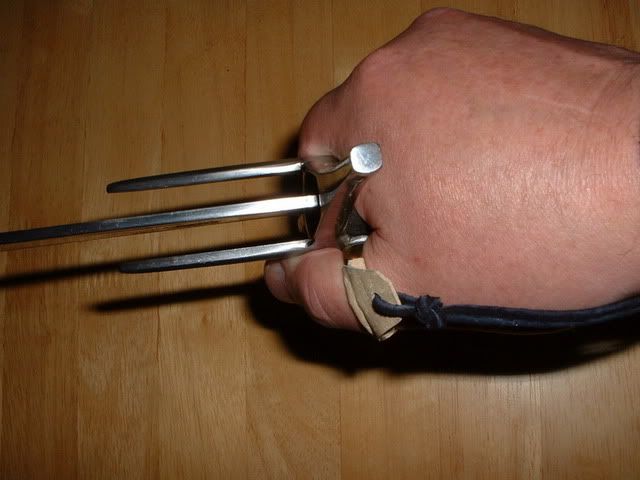
 |
|
|
|
|
#1 |
|
Member
Join Date: Jan 2005
Location: Haifa, Israel
Posts: 183
|
The appearance date of the earliest sabers is vague and so far not finally fixed. It was common to think that the first sabers appeared on the 11 or 12 C. With time, more discoveries moves this date backward and today it is dated to the 9 or 10th C. and may be even earlier.
The saber shown below was excavated in Central Asia, together with a group of several others. As it was not a formal archeological excavation (very unfortunately) any dating or provenance is very speculative, but several experts that examined this blade tends to think it is 9th C. :  Blade length 42 inches, slightly curved, quite heavy and thick, about 10 mm at its base. The tip is double edged for 11 inches with a diamond cross section.  At the base of the blade there is a steel collar used to hold the blade well in the scabbard. The tang has three holes for the grip rivets.  I was lucky to acquire several blades of this lot, and I am glad to share this one with you. |
|
|

|
|
|
#2 |
|
Arms Historian
Join Date: Dec 2004
Location: Route 66
Posts: 9,957
|
This is an outstanding blade!!! and if memory serves it would seem to correspond to Altaic sabres of the period you suggest. The angled tang (which becomes consistant in some Tatar sabres and the 'Mingrelian' shashkas among others) is seen on these 'Altaic' examples. I think there are good drawings of these in David Nicolle's work on the Mongols. The remains of the 'tunkou' at the blade root also seem consistant with these.
What an incredible find, and as noted, how unfortunate that more exacting provenance was lost, It seems the remains of swords of this form were discussed a number of times over many years on these forums...can anybody help with the references in Nicolle (I think it is "the Mongol Warlords" that the drawings are in). I think the heading for the discussions here were 'Siberian sabre' ? Very much looking forward to input on this as it appears an extremely important blade, and fascinating as the long standing and ever developing debates and discussions on the sabre form evolve. Thank you again for sharing this blade!!!  All the best, Jim |
|
|

|
|
|
#3 |
|
Member
Join Date: Mar 2006
Location: Room 101, Glos. UK
Posts: 4,186
|
very interesting, reminds me of my repro 9c magyar sabre:
 similar shape, angled hilt and a semi-sharp upper edge at the tip for the 1st 10 in. this one is only 29in. blade, bronze guard and heavy bronze pommel tho. may help envision what yours looked like when it was new..... |
|
|

|
|
|
#4 | |
|
Member
Join Date: Dec 2004
Location: Bay Area
Posts: 1,625
|
Quote:
As for the dating of sabres, there was a long thread in the forum a while ago. There are plenty of finds from the 9th century as deep into Europe as the Balkans and nowadays Hungary, which means they must have developped in Central Asia at least a century or two earlier. |
|
|
|

|
|
|
#5 |
|
Member
Join Date: Dec 2004
Location: Europe
Posts: 2,718
|
Thank you for showing this rare blade. This made me remember another rare blade I have seen in Persian Steel by J. Allan and B. Gilmour, page 55. It is a slightly curved, single edged blade, 71.5 cm long, found in 9th century archaeological levels at Nishapur. Now at the MET. Here is a map – click to make it bigger http://www.metmuseum.org/TOAH/HD/nish/hd_nish.htm
At an excavation at Merv, where Ann Feuerbach participated, they excavated ingots, although they did not have any iron, it had to be imported, but Merv had at least two big plusses, it had a key position on the Silk Road, and it was an Arabian headquarters at the time. Have a look at the map showing some of the key towns on the Silk Road at the time, Herat, Nishapur, Merv, Bukhara and Samarqand. |
|
|

|
|
|
#6 |
|
Member
Join Date: Jun 2007
Location: D.C. area
Posts: 8
|
Greetings Members,
I am new to the Forum but have been a student of early sabres for many years. These blades have been found over a very large geographical area. I would say from the Danube to the Kirghiz region. If the blade in the photo has some hilt elements it will be possible to say more about dating and place of origin. The collar at the blade base was probably there to keep the blade tight in the scabbard like a habaki on a Japanese blade. They appear on Chinese sabres also. It could be for resting the index finger but the weight of these blades, usually very heavy, doesn't imply that. If anyone wants to see other types of steppe swords let me know, I can try to put up some photos. Tim |
|
|

|
|
|
#7 |
|
Member
Join Date: Apr 2005
Posts: 190
|
Welcome to the Forum, Tim.
I, for one, would be interested in knowing more about early sabres, please do post some photos with descriptions. Ham |
|
|

|
|
|
#8 |
|
Member
Join Date: Dec 2004
Location: Bay Area
Posts: 1,625
|
Hello Tim,
I am glad you joined us, as I have always wanted to learn more about early sabres, because they are the weapon that has always fascinated me the most. No irony intended, I am serious. I like your suggestion that sabres should be classified according to hilt and blade characteristics, rather than the surrounding objects in the burial, because this latter approach does not take into account heirloom blades, that survived for centuries and trophies, which could have been taken from neighboring peoples. The picture I have attached is from Varna's Archaeological Museum and the display features sabres and palashes found in nowadays North-Eastern Bulgaria. They are dated VIII-X centuries, which was South-Eastern Bulgaria back then, if the dating is correct. What would your comments on them be, with regards to dating, origin, etc.? Thanks, Teodor |
|
|

|
|
|
#9 | |
|
Member
Join Date: Mar 2006
Location: Room 101, Glos. UK
Posts: 4,186
|
Quote:
  the 16th C. hungarian sabre however, the ring hits the languets wherever you put the forefinger, the thumb resting on the side of the languet and forefinger ahead of the guard seems the most comfortable, tho i'd want to get everything below the guard before i had to parry anything...and with the 16c sabre i'd rather not have the ring on at all. maybe a hard leather thumb patch on a shooting glove would do. may have to try that some time. of course by the 16th c. i wouldn't be a horsebowman....     as thumb rings vary alot in thickness and even shape, this opinion may not apply to other types of ring, i find the ring is fairly easy to rotate with the forefinger to get the working part out of the way, tho it's more difficult with a glove on..... my bronze thumb ring:  not having access to a horse at the moment, this experimental archeology was done on foot, (and melon targets do not fight back very well either) so results may vary  p.s. - while neither of my repro sabres has the 'collar', the edge is deliberately unsharpened for the 1st two inches from the crossguard as i DO stick my forefinger there on occasion, just not with the archers ring on. Last edited by kronckew; 30th June 2007 at 06:17 PM. |
|
|
|

|
|
|
#10 |
|
Member
Join Date: Apr 2005
Posts: 190
|
Nice complete example, Tim. Do you have others to share?
Ham |
|
|

|
|
|
#11 |
|
Member
Join Date: Jun 2007
Location: D.C. area
Posts: 8
|
Hi Ham,
I do have others, too many in fact. Been collecting early swords for a long time now. Will post pics when I get a minute, got a teenage daughter around for the summer... nuff said.  Teodor those are some interesting swords especially the Bulgar one with the pommel. I have one sword similar but it was found way east of that area, it also has a tribal mark on it. Interesting that the pommel on that Bulgar sword isn't much different in shape than the one on my sabre in the pic above. Looks like there are 2 type pommels, this one with the dome top like a can of Coke somebody left in the sun too long and another one looks like a lightbulb, like on the Magyar swords in the next pic you posted. There is a lot of variation in the guards and blade profiles after the 10 century but the pommels don't change much at all.  Tim |
|
|

|
|
|
#12 |
|
Member
Join Date: May 2007
Posts: 8
|
It all seems to have started with the canted hilt; it added valueable leverage to the straight, double-edged swords of steppe people. Inevitably, the edge to which the hilt was canted became the “primary cutting edge” in use. Then they started to shorten the “secondary cutting edge” where it had no practical use; in the beginning ¼ from the hilt was left unsharpened. When they realized that they could improve the cutting ability by giving a convex curvature to the blade, they further reduced it to ¼ from the tip and they come up with the earliest saber.
Is this a too short summary? 
|
|
|

|
 |
|
|